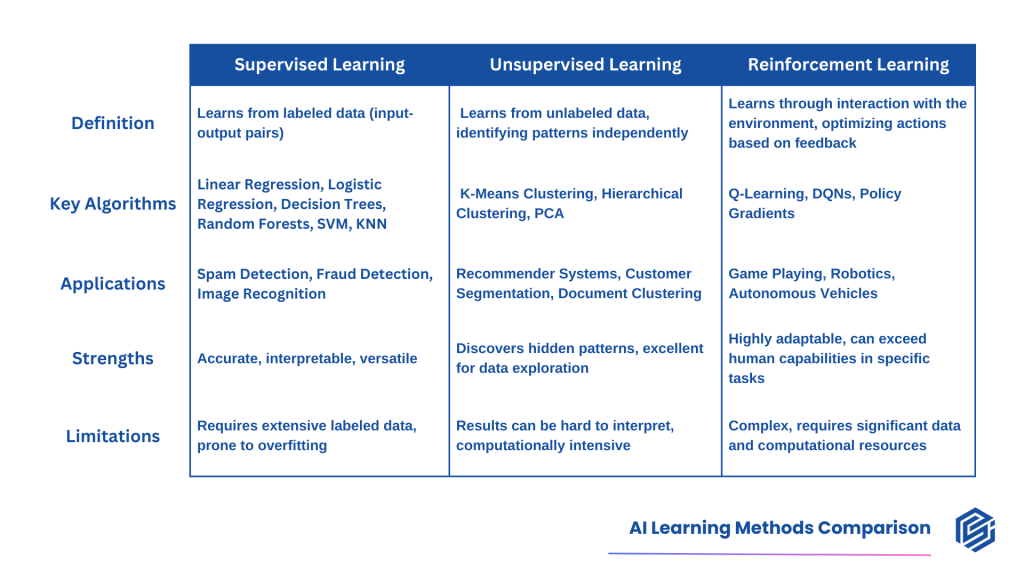Artificial Intelligence (AI) has become a transformative force in numerous industries, reshaping how we interact with technology and data. This article delves into the various learning methodologies employed in AI, specifically focusing on supervised learning, unsupervised learning, and reinforcement learning. We will also examine real-world applications of these methods, illustrating their practical significance.

Supervised Learning
Supervised learning serves as a foundational approach in AI, akin to the process of teaching a child by presenting labeled examples. In this paradigm, the AI system learns from a dataset consisting of input-output pairs, referred to as labeled data. The model develops the ability to associate specific inputs with their corresponding outputs through this structured guidance.
Common Supervised Learning Algorithms
- Linear Regression: This algorithm predicts a continuous outcome based on the linear relationships between input and output variables. For instance, it can forecast housing prices by analyzing factors such as the number of bedrooms, square footage, and location.
- Logistic Regression: Primarily used for binary classification problems, logistic regression estimates the probability that a given input belongs to a particular class.
- Decision Trees: These models utilize a tree-like structure to facilitate decision-making processes based on specific criteria.
- Random Forests: An ensemble method that combines multiple decision trees to enhance accuracy and mitigate the risk of overfitting.
- Support Vector Machines (SVM): This algorithm identifies the optimal hyperplane to differentiate between various classes in the dataset.
- K-Nearest Neighbors (KNN): KNN classifies data points based on the categories of their nearest neighbors within the feature space.
The effectiveness of each algorithm is contingent upon the specific context and dataset, necessitating careful selection based on the problem at hand.
Applications of Supervised Learning
- Spam Detection: Supervised learning excels in spam detection, utilizing extensive labeled datasets of spam and non-spam messages. Algorithms such as logistic regression and decision trees can effectively discern patterns indicative of spam, including specific keywords and sender behaviors.
- Fraud Detection: In the realm of fraud detection, algorithms like random forests and support vector machines analyze transaction patterns to identify anomalies. These models learn from historical fraud cases, enabling them to predict potential fraudulent activities in new transactions.
- Image Recognition and Sentiment Analysis: These domains also benefit significantly from supervised learning methodologies.
Advantages and Limitations
Supervised learning offers several advantages, including high accuracy, interpretability, and versatility. However, it necessitates a substantial volume of labeled data, which can be time-consuming to gather. Additionally, there is a risk of overfitting if the training data lacks comprehensiveness.
Unsupervised Learning
Unsupervised learning represents a distinct methodology wherein the AI system explores data without pre-existing labels. In this approach, the AI identifies patterns and structures within the dataset independently.
Techniques in Unsupervised Learning
- K-Means Clustering: This algorithm partitions data into a predetermined number of clusters (k), grouping data points that exhibit similarity.
- Hierarchical Clustering: This technique creates a tree-like structure of clusters through iterative merging or splitting based on proximity.
- Principal Component Analysis (PCA): A dimensionality reduction technique that transforms data into a new set of variables, known as principal components, while preserving variance.
Applications of Unsupervised Learning
- Recommender Systems: Unsupervised learning enhances recommender systems by clustering similar users, allowing for personalized suggestions based on collective behavior patterns.
- Customer Segmentation: Algorithms like K-Means clustering facilitate customer segmentation based on purchasing behavior, enabling businesses to tailor marketing strategies and improve customer satisfaction.
- Document Clustering and Genome Analysis: These techniques aid in organizing text data and identifying patterns in genetic datasets, respectively.
Advantages and Limitations
The primary strength of unsupervised learning lies in its capacity to uncover hidden patterns, making it invaluable for data exploration. However, the interpretability of results can be challenging, and the absence of clear patterns may hinder effectiveness. Additionally, unsupervised learning often demands significant computational resources.
Reinforcement Learning
Reinforcement learning is a dynamic approach in which AI learns through interaction with its environment, employing trial-and-error methodologies to optimize actions based on feedback in the form of rewards or penalties.
Techniques in Reinforcement Learning
- Q-Learning: An off-policy algorithm that evaluates the value of actions in specific states, guiding the AI in selecting optimal actions.
- Deep Q-Networks (DQN): This technique integrates Q-learning with deep neural networks, allowing the model to process high-dimensional inputs effectively.
- Policy Gradients: This method optimizes the policy directly by updating it in a manner that maximizes expected rewards.
Applications of Reinforcement Learning
- Game Playing: Reinforcement learning has achieved remarkable success in gaming, exemplified by models such as AlphaGo, which learned to play Go at a superhuman level by exploring a vast array of potential moves.
- Robotics: This approach enables robots to master complex tasks by interacting with their environment, optimizing their actions through trial and error.
- Autonomous Vehicles and Network Optimization: Reinforcement learning is critical for decision-making processes in autonomous vehicles and for dynamically adjusting network configurations to achieve optimal performance.
Advantages and Limitations
Reinforcement learning is highly adaptable and can surpass human capabilities in specific tasks. However, its complexity requires substantial data and computational resources to operate effectively.
Harnessing AI Learning Methods for Business Success
Successfully implementing AI solutions requires not only a solid understanding of the various learning methodologies but also a clear grasp of the business challenges you aim to address. Leveraging supervised, unsupervised, and reinforcement learning effectively allows organizations to unlock valuable insights and drive impactful outcomes.
At Predictive Systems Inc., we specialize in guiding businesses through the complexities of AI to tackle their most pressing challenges. Contact us today to discover how we can assist you in designing, developing, and deploying AI systems tailored to your specific business needs.


